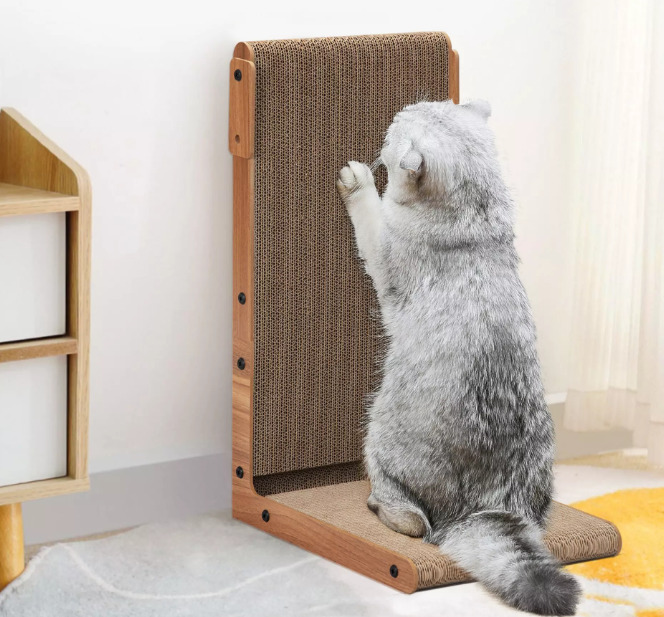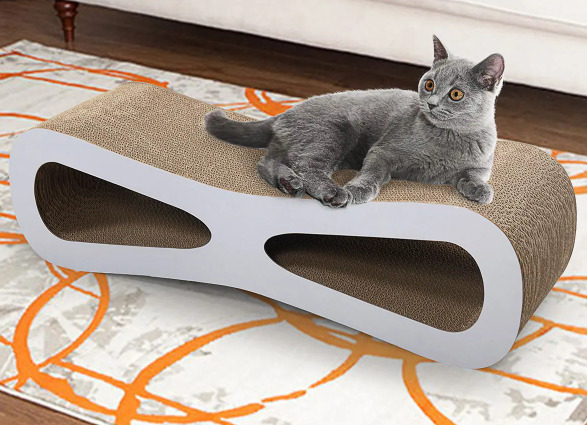Cats are enchanting creatures, but their natural instinct to scratch can leave your furniture looking worse for wear. While scratching is essential for maintaining their claws and marking territory, it doesn’t mean your cherished belongings have to suffer. In this blog, we’ll explore practical and humane ways to deter your feline friend from using your furniture as a cat scratching post, ensuring both your decor and your cat’s well-being remain intact.
Scratching is an innate behavior for cats, serving multiple purposes, including claw maintenance, stretching, and marking. Understanding why cat scratches furniture is the first step toward finding effective solutions to redirect their behavior.
Provide Attractive Alternatives to Prevent Cat Scratching
- Provide Scratching Alternatives
To save your furniture, offer your cat appealing alternatives. Invest in cat scratching post made from materials like sisal, cardboard, or wood. Place these posts near the furniture your cat tends to scratch. By giving your cat designated scratching spots, you channel their natural behavior into appropriate areas.
- Choose the Right Scratching Post for Cats
Selecting the right cat scratching posts is crucial. Opt for a post that matches your cat’s preferences—some cats prefer vertical posts, while others prefer horizontal surfaces. The scratching post should be tall enough for them to stretch fully and sturdy enough to support their weight without wobbling.
- Make Cats Scratching Post Attractive
Entice your cat to use the cat scratching post by making it irresistible. Rub catnip or attach dangling toys to the post. You can also scratch the post yourself to leave your scent, encouraging your cat to mark it as their territory.
- Use Cat Furniture with Built-in Scratching Surfaces
Consider cat furniture that incorporates scratching surfaces. Cat trees, condos, and shelves with built-in cat scratching pad provide your cat with both vertical space for climbing and horizontal surfaces for scratching.

Encourage Positive Associations to Prevent Cat Scratching
- Positive Reinforcement
Reward your cat when they use the cat scratching post correctly. Offer treats, praise, or affection whenever you catch them in the act of scratching the designated area. Positive reinforcement helps them associate the cat scratcher post with positive experiences.
- Double-Sided Sticky Tape
Cats often dislike the sticky texture of tape on their paws. Cover the areas of your furniture that your cat tends to scratch with double-sided sticky tape. The uncomfortable sensation discourages cat scratching.
- Furniture Coverings
Protect your furniture with removable coverings like slipcovers or decorative blankets. Cats are less likely to scratch surfaces that are unfamiliar or have a different texture. If your cat is particularly drawn to a specific piece of furniture, consider using a temporary, decorative cover. These covers protect your furniture from damage while you work on redirecting your cat’s scratching behavior. If the cat scratching behavior persists despite your efforts, consider seeking advice from a veterinarian or a professional animal behaviorist. They can provide tailored guidance and insights into your cat’s behavior, helping you develop an effective strategy to address the issue.
- Training with Water Spray
While this approach should be used with caution and only as a last resort, a gentle water spray can prevent cat scratching. Ensure the spray is mist-like and not forceful. The goal is to associate the unpleasant sensation with the act of scratching the furniture.
Environmental Enrichment to Prevent Cat Scratching
- Environmental Enrichment
Provide ample environmental enrichment to keep your cat mentally and physically stimulated. Boredom can sometimes lead to excessive cat scratching. Offer interactive toys, puzzle feeders, and engaging play sessions to keep your cat entertained and less likely to resort to destructive scratching.
- Cat Scratching Pad and Cat Scratching Board
In addition to scratching posts, consider using cat scratch pads or cat scratching board. These can be placed directly on or near the furniture your cat tends to scratch. Some scratching pads come with catnip or enticing textures that encourage scratching.
- Scent Deterrents
Cats have a strong sense of smell. Use scent deterrents, such as citrus sprays or diluted essential oils, on the furniture to discourage cat scratching. Cats typically dislike these scents and will avoid the treated areas.

Grooming and Claw Maintenance to Prevent Cat Scratching
- Trim Their Claws
Regular claw trimming reduces the potential damage caused by cat scratching. Use specialized cat claw clippers and trim just the tip of the claws to prevent injury.
- Soft Claw Caps
Soft claw caps, also known as claw covers, can be placed over your cat’s claws to prevent them from causing damage when cat scratches furniture. These caps are safe and temporary, usually lasting about 4-6 weeks.
- Regular Nail Trimming:
Incorporate regular nail trimming into your cat’s grooming routine. Trimming their nails reduces the potential for damage when cat scratches. If you’re unsure how to trim your cat’s nails, consult your veterinarian or a professional groomer for guidance.
Consistency and Professional Guidance
Be patient and consistent in redirecting the cat scratching behavior. It might take time for them to fully transition to the designated scratching areas. Whenever you catch your cat scratching furniture, gently guide them to the scratching post and encourage them to use it.
Preventing your cat from scratching furniture requires patience and understanding of their natural behavior. By providing appealing alternatives, attractive scratching posts, and positive reinforcement, you can redirect the cat scratching instinct toward appropriate surfaces. Remember that scratching is a vital part of your cat’s life, so finding a solution that keeps both your furniture and your cat content is a win-win situation. With consistent efforts and a bit of creativity, you can create an environment where your cat thrives while your furniture remains intact and beautiful.
https://www.washingtonpost.com/home/2022/11/01/stop-cat-scratching-furniture/

